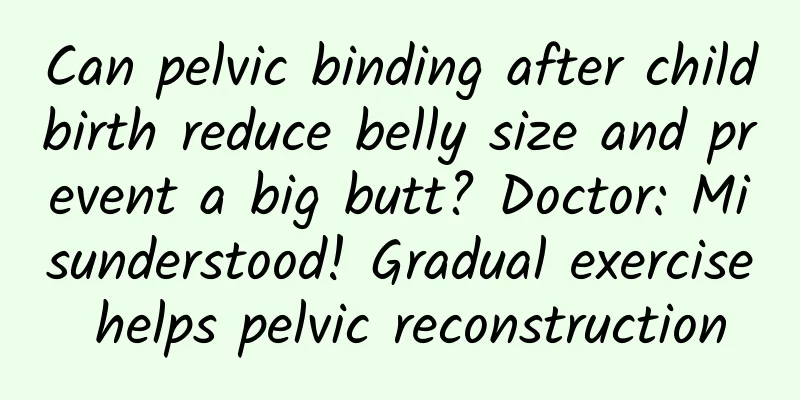Can pelvic binding after childbirth reduce belly size and prevent a big butt? Doctor: Misunderstood! Gradual exercise helps pelvic reconstruction

|
The most feared thing after giving birth is that the abdomen cannot shrink, the buttocks become bigger, and look like an "old hen". Therefore, there is a practice of using a pelvic belt to "bind the pelvis", which is said to shrink the abdomen, prevent the buttocks from getting bigger, and even help lose weight after giving birth. It was recently reported that female star Sui Tang had also tried pelvic binding. Is pelvic binding useful after giving birth? Don't misunderstand, says the obstetrician and gynecologist! There is a practice called "binding the pelvis" using a pelvic belt, which is said to reduce the abdomen, prevent the buttocks from getting bigger, and even help with weight loss after childbirth. Sui Tang has given birth to three children, but she still maintains the figure of a supermodel, and her postpartum care has always attracted attention from the outside world. According to news reports, she tried pelvic binding, but she also once left a message on her personal Facebook saying that she felt that this trick might not have any effect on her, perhaps because everyone's physique is different... Does the pelvis really get bigger after giving birth? Can pelvic binding really help you lose belly fat and avoid a big butt? This topic draws everyone's attention to several key issues. The first is whether the pelvis really gets bigger after giving birth. Can binding the pelvis after childbirth really help slim down your belly and avoid a big butt? Obstetrician and gynecologist Cai Fengbo said that our bone structure is fixed. Indeed, during pregnancy, due to hormones, muscles are more relaxed and weak, and internal organs droop, we may feel that our bones have become bigger. However, in fact, the abdominal and pelvic cavity will not be stretched due to childbirth. Some women gain weight during pregnancy, but they blame it on the widening of the pelvis. In fact, a fixed pelvis does not actually get bigger, nor does it need to be bound. Therefore, do not blame the pregnancy process for stretching your pelvis and causing your body to become out of shape. Especially after giving birth, you still need to rely on appropriate staged exercise and a balanced diet to help lose weight and restore your pre-pregnancy figure, instead of pinning your hopes of losing weight on binding your pelvis. The structure of our bones is fixed and will not be stretched by childbirth. The pelvic function should be fully restored within 3 months after delivery to avoid any damage. Doctor: The bone structure is fixed, and the abdominal and pelvic cavity will not be expanded due to childbirth. Gynecologist Cai Fengbo said that in his medical career, there was only one time when he was an intern at Kaohsiung Chang Gung Memorial Hospital. During his internship, he witnessed a woman who was unable to give birth naturally. The baby was stuck in the middle of her pelvis and could not be pulled out by caesarean section. The baby could not go up or down, so they had to urgently ask an orthopedic surgeon to cut the pubic symphysis and open the pelvis to deliver the baby. This is the only case in my life where I have witnessed a pelvic deformity due to childbirth. Many pregnant women have bigger buttocks after giving birth. In fact, it is because of pear-shaped obesity or induced polycystic ovary syndrome. Therefore, do not misunderstand it as pelvic deformation. Since the pelvis has not been widened by childbirth, there is of course no need to bind the pelvis, and there is no need to discuss whether it is effective or not. If you still insist on binding the pelvis after delivery, and do it dozens of times, for obese mothers, mothers at risk of thrombosis, or mothers with limited mobility, this method of binding will hinder venous return and increase the risk of deep vein thrombosis. The pelvic function should be fully restored within 3 months after delivery to avoid any damage. Postpartum means the end of pregnancy, but for pelvic function reconstruction medicine, it is the beginning of recovery. Due to the impact of childbirth and pregnancy, the postpartum pelvic tissue is in a stage of tissue injury and deformation, edema, excessive ligament stretching and extension, and local nerve demyelination. The recovery time ranges from 3 weeks to one and a half months. Pay special attention to urinary incontinence, urgency and frequent urination, chronic pelvic pain caused by abnormal pelvic function, and lower back pain or a feeling of falling caused by pelvic relaxation. If the pelvic function cannot be fully restored within 3 months after delivery, this type of injury often becomes permanent and leaves sequelae. To strengthen the pelvic floor, it is best to wait until 8 weeks after delivery, when nerve function has fully recovered, before performing Kegel exercises. Many women can't wait to use belly bands, waist belts or shaping bras right after giving birth, or even do body shaping exercises such as sit-ups. Gynecologist Cai Fengbo reminds us that according to the aforementioned principle of pelvic reconstruction function, these abdominal belts and shaping bras will restrict the expansion of the abdominal cavity. Therefore, the abdominal pressure generated when coughing, lifting heavy objects or holding a child will be directed directly to the bottom layer of the pelvis. If you do sit-ups in addition, the bottom layer of the pelvis will be under even greater pressure. You should not consider body shaping immediately after giving birth, but should adopt gradual exercise in stages The implementation of postpartum exercises also varies depending on the different parts of the body that are subjected to force. General passive limb activities, including raising hands, expanding chest, and lifting legs, can be performed after delivery. However, since exercises to strengthen the abdominal muscles will increase the burden on the pelvic floor muscles, you have to wait 6 to 8 weeks before implementing them. As for Kegel exercises to strengthen the pelvic floor, it is best to wait until 8 weeks after delivery when nerve function has fully recovered before performing them. In short, you should not consider body shaping or figure issues immediately after giving birth, but should focus on resting and recovering the pelvic tissue. |
Recommend
Is Leep Knife good for treating cervical erosion? It has a good effect
Leep knife has a good effect in treating cervical...
What fruits are good for irregular menstruation?
According to relevant medical experts, menstruati...
How long does it take to get pregnant before you can use medication to induce abortion?
Roses, candlelight dinners, chocolates, and the r...
Burdock water has many magical uses! High potassium and low sodium reduce edema and promote defecation
Burdock, known as the "Oriental ginseng"...
What are the symptoms of chronic cervicitis?
Chronic cervicitis is the most common gynecologic...
Experts answer common hazards of cervical erosion
With the increasing number of patients with cervi...
How to care for pelvic effusion
Pelvic inflammatory disease is a very common gyne...
What are the ways to prevent vaginitis in women?
What are the methods to prevent female vaginitis?...
Is it easy to have ectopic pregnancy if you have ovarian cysts? How can you cure it?
Does having ovarian cysts make you more susceptib...
3 cooking methods to prevent obesity and lower blood sugar with anthocyanins without wasting nutrients
Office workers are under great pressure in life, ...
How to prevent ectopic pregnancy?
How to take preventive measures against ectopic p...
Combination of Chinese and Western medicine in treating pelvic peritonitis
There are more and more gynecological diseases in...
In the late pregnancy, I feel like I have dysmenorrhea and I often have diarrhea.
In late pregnancy, the feeling of dysmenorrhea an...
Does low anti-Mullerian hormone mean premature ovarian failure?
Low AMH does not necessarily mean premature ovari...
How to determine whether it is endometriosis and what causes it
The diagnosis of endometriosis requires laparosco...









